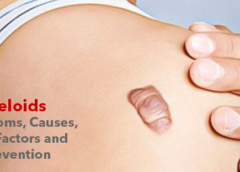Overview
Fibrous tissue called scar tissue grows around the wound to heal and protect the injury when skin injure. The extra scar tissue develops in some cases, producing smooth, rough growths called keloids.
Keloids can be considerably larger than the original cut. Most usually they are found on the chest, shoulders, earlobes and cheeks. Keloids, however, can affect any part of the body.
Although keloids are not harmful to your health, they may be causing cosmetic concerns.
Symptoms
Keloid scars tend to develop and grow slowly. It can take a few months, or even longer than a year, for a keloid scar to appear. The proliferating scar may continue to grow and spread for weeks, months or years. However, it is possible for a keloid scar to grow and spread very quickly. They range in size from small dots to large growths of 12 inches or more. The most commonly appear on the ears, face, neck, shoulders, upper back, and chest. Scars on the upper trunk tend to be the largest.
Common keloid scar symptoms include:
- Pain, itching or tenderness. Large scars can also limit movement of the affected body part.
- Pink, red or purple colour. The scar is usually darker than a person’s normal skin tone. It may continue to darken with time and sun exposure.
- Raised skin surface that feels different from surrounding skin. The raised area is usually fixed in place, meaning you can’t move it. Larger keloids can restrict movement.
- Soft, rubbery or hard texture
Causes
A keloid forms due to the skin’s exaggerated response to an injury. Even minor cuts can cause keloids. Some of the most common causes of keloids include:
- Cuts Or Punctures, Including From Shaving
- Burns
- Incisions From Surgery
- Insect Bites
- Skin Conditions, Such As Acne
- Chickenpox Or Diseases That Cause Scarring Of The Skin
- Tattoos Or Piercings
Some keloids form without any apparent cause. Some keloids have been known to occur without a skin injury. They may also crop up years after an injury has taken place.
When the skin gets wounded, it sends cells that make collagen to repair the wound. Ideally, the cells do their job and finish the damage, leaving a slight scar behind. With keloids, cells in the skin keep growing even after the wound has healed. The scar tissue keeps rising, forming a big, raised scar.
Though keloids can occur in any skin type, they are more likely to form in:
- Those who have a family history of keloids
- People under 30, especially teenagers going through puberty
- Pregnant women
- People with darker skin tones, such as those people of asian, hispanic, or african-american descent, are also more likely to develop keloids than other people.
Keloids are considered to be a type of benign tumour. Though they can be bothersome, they do not turn into cancer or pose serious health problems.
Risk Factors
Keloid scars occur in about 10% of the population. It is unclear why some people develop keloid scars and others do not. However, several factors increase the risk of developing them. Risk factors for keloid scars include:
- African, Asian, Hispanic or Latino descent. The risk is 15 to 20% higher in these groups with darker skin tones.
- Age between 10 and 30 years
- Family history of keloid scars. About 1 in 3 people with keloids have a parent, sibling or child who also has them.
There may also be a link between sex hormones and keloid scars. Research suggests a higher incidence of keloid scarring during puberty and pregnancy. In women, keloid scars tend to shrink in size after menopause.
Reducing your risk of keloid scars
There are steps you can take to help prevent keloid scars. You may be able to lower your risk of developing a keloid scar by:
- Avoiding piercings and tattoos. If you notice the skin thickening around an ear-piercing, wear a pressure earring. Using this device for up to six months may prevent a keloid scar if you start it soon enough.
- Protecting bites, cuts, and other wounds from the sun with bandages or clothing while the wound heals. After healing, use SPF 30 or higher sunscreen daily.
- Treating wounds right away by gently washing the wound daily, applying a thin layer of petroleum jelly, and covering with a sterile bandage. Use the first-aid tape to apply constant and even pressure on the wound.
- Using a silicone gel sheet to cover the wound after it has healed completely. Wear the sheet for 12 to 24 hours a day for three months.
- Using pressure dressings and garments after surgery
If you know you are at risk of developing keloid scars or have already had one, work with a dermatologist. There may be specific products and dressings your dermatologist recommends to manage wounds and prevent keloids.
Complication
There are generally few complications from keloid scars. They can cause some psychological distress depending on their appearance and position because keloids can be very prominent. Keloids may also interfere with movement, especially when they are on a joint. Very rarely, keloids may become cancerous.
Prevention
Treatments for keloid scarring can be difficult and not always effective. For this reason, it’s important to try to prevent skin injuries that could lead to keloid scarring. Using pressure pads or silicone gel pads after an injury may also help prevent keloids.
The exposure to sun or tanning can discolour the scar tissue, rendering it slightly darker than the skin around you. It can bring out the keloid more. Keep the scar hidden while in the light to prevent discolouration. Find out more about sunscreen and other ways you can protect your skin.

Leave a Reply
You must be logged in to post a comment.